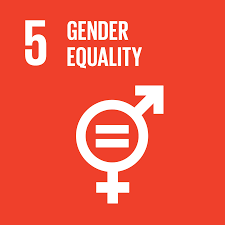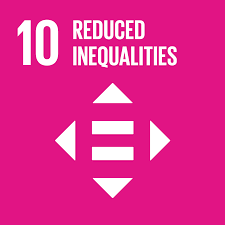#Weneedtotalk: Keeping Our Daughters Safe
- Ann Yaa Safo

- Jul 21, 2020
- 7 min read
This article focuses on the following Sustainable Development Goals:
Every single day, the lives of several young women are threatened due to gender-based violence. Described as a ‘shadow pandemic’ in the Africa Renewal magazine, this terrible and widespread societal malady hinders our achievement of SDG 5: Gender Equality, SDG 10: Reduced Inequalities, and SDG 16: Peace, Justice, and Strong Institutions.
Figures from the WHO (World Health Organization) are even more alarming: the global proportion of women who have “experienced physical or sexual partner violence or non-partner sexual violence” is at a staggering 35%. It is very unfortunate that we continue to battle with gender-based violence when, in as far back as 2006, the World Health Assembly declared violence against women a “leading worldwide public health problem”.
The United Nations provides the following definition for violence against women: “any act of gender-based violence that results in, or is likely to result in, physical, sexual or mental harm or suffering to women, including threats of such acts, coercion or arbitrary deprivation of liberty, whether occurring in public or in private life’’.

Far from being solely physical, the effects of gender-based violence are psychosocial as well. One of the biggest effects on women and girls is that it limits their participation in all spheres of society, and, worse still, it acts as an impediment to their educational and economic empowerment.
A huge number of intervention measures geared towards gender-based violence have been survivor-oriented. While this is laudable, our primary focus should be on prevention rather than treatment or cure. And we can only do this if we address its root causes within our communities and social structures.
The best problem-solving model, of course, involves a combination of preventive strategies and mitigating factors.
One of the most significant measures we can take is to actively involve young boys and girls in all our educational and activism efforts. This is perhaps the most important way to ensure sustained progress in the fight against gender-based violence. The youth are often overlooked because they are ‘too young’ or ‘not mature enough’, but this critical stage of their lives shapes their values and attitudes they uphold and determines whether they imbibe a culture of respect for all sexes and healthy ideas of gender, or whether they do not.
Education is essential if we want to succeed in our bid to achieve SDG 5: Gender equality and SDG 10: Reduced Inequalities. In recognition of this, the UN Women and the World Association of Girl Guides and Girl Scouts have launched Voices against Violence, a non-formal curriculum aimed at ending violence against women and girls. It is designed for various age groups ranging from 5 to 25 years and includes a handbook that emphasizes peer education for the delivery of age-appropriate sessions.
Some activities worthy of mention are:
Storytelling and games that introduce discussions of gender bias and stereotypes for younger users.
Poster competitions.
Visiting and volunteering with local shelters.
Developing local community-based campaigns and projects to address specific forms of violence against girls and women.
Additionally, there are a number of harmful traditions that we need to eliminate if we want young girls to feel truly safe, loved, and protected within our communities. Among them are female genital mutilation, child marriage, and the vestal system. These are entrenched within the cultures of communities, and can only be eradicated if we engage community leaders at every stage of the process: education, implementation of intervention programs, prevention of further perpetuation. In a large number of traditional societies, men are the established community leaders. This further highlights the need to involve men, who have been shown to make up the majority of perpetrators of gender-based violence, in our efforts. This is critical if we want to eliminate gender-based violence in the long term. We need to teach men about women’s rights, gender equality, and gender-based violence.
While teaching men is critical, it is not enough to solve this problem. Involving the wider community so as to redefine societal norms and values. Encouraging discussions within the wider community on issues of gender-based violence, and challenging preconceived notions of acts that constitute gender-based violence fosters helps prevent the normalization of violence against women. By engaging community members to discuss the behaviors and beliefs that can lead to violence against women, we can create opportunities to bring lasting change to the realities women face.
In our bid to help women and girls, we need to remember that one of the biggest hurdles for women fleeing situations of abuse is financial dependency. Many victims of abuse rely on their partners for money even for essentials like food and housing. Leaving may mean being unable to meet their basic needs, and, in the very common case that the man refuses to cater to the needs of their children as well. It is imperative to work with women to help them acquire entrepreneurial skills, gain financial literacy, and connect them to income-generating opportunities that empower them to attain financial independence so as to get a secure, fresh start to life. The assistance provided can take the form of short courses, linking them up with mentors in fields they’re interested in or assisting them to access financial aid until they get back on their feet. Or it could simply be supporting women to rebuild their confidence to apply for jobs and study opportunities.
An alarming phenomenon that permeates today’s society is the existence of regressive forces. This refers to the rancor and ‘increasing roll-back on the hard-won rights of girls and women across the globe’ which Plan International CEO Ann-Brigitte Albrectsen recently wrote about. Survivors of violent acts are often reluctant to speak after they have been assaulted because there is an atmosphere of hostility rather than support for victims in many societies. Many women and girls fear that they will lose their jobs, be forced to leave school, or suffer social isolation. It is only if we create an environment that makes survivors feel safe enough to speak up about the trauma they have suffered and call out their attackers that we can make a meaningful impact in the lives of women and girls.
In today’s society in which there is such silence and stigma around acts of violence against women, it may be very difficult for victims to ask family and friends for help. Women need a safe haven to go to when they decide to remove themselves from horrific situations, hence the need for safe houses, crisis centers, and women’s shelters. These centers provide shelter, information, and support services such as food, accommodation, medical treatment, financial aid, and legal referrals. Most importantly, however, they provide counseling which is essential in the recovery process. They are a true godsend for suffering women everywhere.
Finally, to support efforts to achieve SDG 16: peace, justice, and strong institutions, lawmakers must create laws that empower survivors rather than rapists. A great many of our court systems are patriarchal. With this foundation of entrenched sexism, many cases of violence are not treated with the seriousness they deserve. It is essential that we make laws around gender-based violence as clear as possible so that women are fully aware of their legal rights. In addition, women’s rights organizations can assist women to protect their rights by connecting them with police, offering basic legal advice, and assisting them in filing legal complaints.
Plan International says on its website: “We must take a stand now, or risk further loss of rights. And when I say loss of rights this often equates to loss of life.”
If we care about the lives of our daughters like we say we do, then we truly need to talk.
NB: We need to talk is an initiative by the UN campaign Girl Up, that seeks to promote collaboration and deep discussion into the issues that have plagued girls over the years, and continue to affect them even now.
External Resources
Visit this site to read Voices against Violence.
To analyze the contributions of each country towards this worthy cause, visit: the global database on violence against women
More publications: from the UN Women website
Learn about the use of sexual violence during past and recent conflicts in the following countries: Democratic Republic of Congo, the Guatemalan civil war, or the Kosovo conflict
Donate to support the work of UN Women here
For a list of crucial areas to invest to end GBV.
Click here for an infographic:
Educate yourself on the website WOMEN DELIVER
To reads the research findings and reports from the studies conducted so far, see The World Bank Development Marketplace
Visit CDC’s STOP SV: A Technical Package to Prevent Sexual Violence
The following are some programs in the CDCs STOP SV Package that target specific areas in the fight against gender-based violence.
Safe Dates: Program designed to prevent the initiation of emotional, physical, and sexual abuse in adolescent dating relationships
Shifting Boundaries: A program designed to reduce dating violence and sexual harassment among adolescents
Green Dot: A bystander-based prevention program designed to reduce sexual and other forms of interpersonal violence perpetration and victimization
Second Step: Student Success Through Prevention (SS: SSTP): A school-based program aimed at reducing bullying, peer victimization, and other problem behaviors
Coaching Boys Into Men: A dating violence prevention program that uses the relationships between high school athletes and their coaches to change social norms and behaviors.
Bringing in the Bystander: A bystander education and training program designed for male and female college students.
Works Cited
“Supporting Elimination of Gender-Based Violence.” World Health Organization, www.who.int/westernpacific/activities/supporting-elimination-of-gender-based-violence. Accessed 19 July 2020.
Mutavati, Anna, and Maniza Zaman. “Fighting the ‘Shadow Pandemic’ of Violence against Women & Children.” Africa Renewal, 15 July 2020, www.un.org/africarenewal/web-features/coronavirus/fighting-%E2%80%98shadow-pandemic%E2%80%99-violence-against-women-children-during-covid-19.
“Prevention Strategies|Sexual Violence|Violence Prevention|Injury Center|CDC.” CDC, www.cdc.gov/violenceprevention/sexualviolence/prevention.html. Accessed 19 July 2020.
“16 Ways to End Violence towards Girls.” Plan International, plan-international.org/ending-violence/16-ways-end-violence-girls. Accessed 19 July 2020.
Lockwood, Beatrix. "9 Ways to Fight Rape Culture." Learn Religions, Feb. 11, 2020, learnreligions.com/fight-rape-culture-712274.
“Development Marketplace: Innovations to Address Gender-Based Violence.” World Bank, www.worldbank.org/en/programs/development-marketplace-innovations-to-address-gender-based-violence. Accessed 19 July 2020.
“16 Ways You Can Stand against Rape Culture.” UN Women, www.unwomen.org/en/news/stories/2019/11/compilation-ways-you-can-stand-against-rape-culture.
7 Ways to Fight gender-based violence. (2016, November 25). Retrieved July 19, 2020, from https://iwda.org.au/7-ways-to-fight-gender-based-violence/
Terry, Amanda. “Six Ways to End Gender-Based Violence.” Degrees, 30 Nov. 2018, degrees.fhi360.org/2016/12/six-ways-to-end-gender-based-violence.
“What We Do: Ending Violence against Women: Focusing on Prevention to Stop the Violence.” UN Women, www.unwomen.org/en/what-we-do/ending-violence-against-women/prevention. Accessed 19 July 2020.








Comments